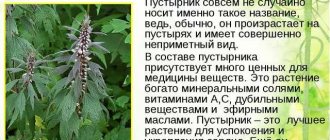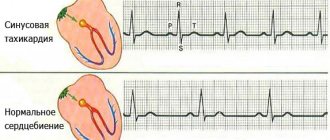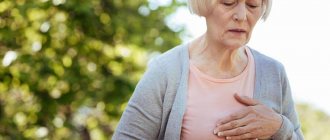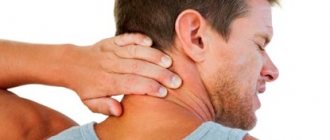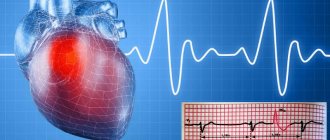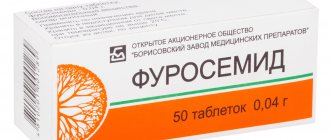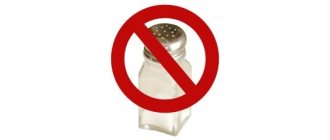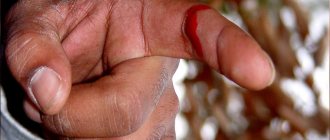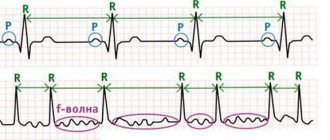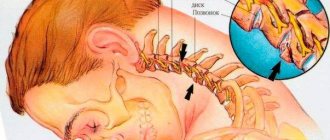Bradycardia is a simple slowing of the heart rate, while a regular but rare heartbeat is observed. There are no interruptions or extraordinary contractions; the heart rate is about 30–50 beats per minute.
Treatment of bradycardia in the early stages does not cause any particular difficulties; you can often get by with folk remedies, but if the situation worsens, a significant deterioration in the patient’s well-being may occur.
Mild bradycardia does not pose a serious threat to the body, however, very often it can serve as one of the first signs indicating the beginning of a pathological process or a malfunction in the body. Therefore, a visit to the doctor and treatment for this condition should not be postponed.
Advice! If the reason for the rare rhythm is not severe structural disorders of the conduction system of the heart, then there are many folk recipes that allow you to speed up the heart rate at home.
Folk remedies for cardiac bradycardia
It is useful to use folk remedies for bradycardia together with medications prescribed by a doctor. If a person has an attack and requires emergency help, some unconventional methods will help normalize the condition and prevent the development of negative consequences. Based on natural ingredients, you can make effective decoctions, infusions and tinctures. The treatment regimen and prescriptions must be agreed with the doctor.
Forms of bradycardia
Pathology occurs as a result of damage to the heart muscles, which subsequently leads to organ failure or its sudden stop. It is worth noting that for professional athletes, bradycardia can be a normal condition.
In medical practice, there are several forms of pathology:
Sinus - appears when the sinus node malfunctions. This type is often found among athletes who are in excellent shape. Often does not require therapy.
Atrioventricular block occurs during impulse failure.
Atrial fibrillation is a failure of heart function that requires hospital treatment under the supervision of doctors.
Physiological - the form appears during sleep, when all organs are at rest and slow down their work.
Only when the sign of the disorder, the type and its form are determined, can folk remedies be used for treatment. The properties of each method are different, and a composition that is useful for one person may be contraindicated for another. Before using traditional medicine, it is better to discuss the possibility of taking it, indications and other important points with your doctor.
Efficiency
Sinus bradycardia is a type of arrhythmia during which there is an irregular heartbeat and a decrease in heart rate of less than 60 beats/min. The causes of this pathology are varied, the symptoms are pronounced. The disease can be cured using complex methods, therefore, in addition to traditional therapy, bradycardia is often treated at home using unconventional means. Traditional medicines are not able to influence the root causes of the disease, but with their help it will be possible to relieve associated symptoms, strengthen the heart muscle, normalize blood pressure, and increase the body's protective functions.
Folk remedies have a number of advantages, among which the most significant are:
- There are a minimum of side effects, and if used correctly and the treatment regimen is followed, they are completely absent.
- A variety of recipes and methods of use, so everyone can choose a convenient and optimal option for themselves.
- Cheapness of ingredients used as a basis for the preparation of medicines.
- Safety.
Return to contents
Features of bradycardia
Bradycardia is manifested by a decrease in heart rate (HR) to 50 or lower. She does not pose any particular danger to life. The exception is severe forms of arrhythmia, which are characterized by a pulse of less than 40 beats per minute. In this case, it will be necessary to provide emergency medical care to the patient.
There are 3 types of disease:
- physiological, manifested due to physical activity;
- sinus, arising due to weakening of the sinus node;
- non-sinus, caused by impulse blockade.
The physiological type of bradycardia is not dangerous. It is typical for people who constantly receive physical activity. Often a rare pulse is detected in a child attending 2-3 classes or a professional athlete. Seizures occur at rest, so they are often detected at night. In older people, the physiological form of bradycardia occurs due to age-related changes that affect all organs and tissues.
Sinus and non-sinus types of arrhythmia require treatment. If the causative factor is not identified and assistance is not provided to the patient, he may develop the following complications:
- cardiac ischemia;
- heart attack;
- heart failure.
According to the degree of manifestation, bradycardia is divided into the following types:
- the absolute form manifests itself constantly, regardless of the state;
- relative arrhythmia occurs after receiving loads;
- moderate bradycardia is typical for children with respiratory arrhythmia;
- the extracardiac form has a chronic course.
Bradycardia is also classified according to the causative factor:
- The extracardiac form is a consequence of stroke, ulcers, cancer, hypertension, increased ophthalmotonus, neuroses and vegetative-vascular dystonia.
- Organic bradycardia occurs due to heart disease (cardiosclerosis, heart attack, myocarditis).
- The medicinal form is a consequence of taking drugs with antiarrhythmic effects.
- The toxic form of the malfunction develops due to acute intoxication of the body caused by hepatitis, infection, high levels of potassium and calcium and other factors.
Healthy recipes
Herbal infusions
A complex herbal mixture, which includes the following components, can help get rid of bradycardia:
- nettle;
- rose petals;
- black currant leaves;
- chamomile flowers;
- yarrow;
- valerian root.
The recipe is as follows:
- Mix all herbs in equal proportions.
- Separate 1 tsp. mixture and pour 250 ml of boiling water.
- Cover the container with a lid and let it brew in a warm place for half an hour.
- Strain the finished drink, drink warm 3-4 times a day after the main meal.
Return to contents
Dill seed tincture
This remedy can not only treat bradycardia. It also has a beneficial effect on blood vessels, dilating them, normalizing blood pressure, strengthening the heart and evening out the pulse. The tincture is prepared using this method:
- Grind a heaping spoonful of dill seeds in a coffee grinder.
- Place 500 ml of red wine on the fire and boil.
- Add crushed seeds, boil for 10 minutes. over low heat.
- Infuse the product for 1 day, after which, without straining, put it in the refrigerator.
- Drink the tincture within 10-15 minutes. every time before meals, 1.5 tablespoon.
Return to contents
Yarrow
If you need to speed up your pulse during bradycardia, you need to drink an infusion based on yarrow, which quickly normalizes blood pressure. You can prepare it using this method:
- Pour 20 g of dried herb into 300 ml of boiling water.
- Place the product in a steam bath and let stand for another 20 minutes.
- Strain, take 3-4 times a day, 1 tbsp. l.
You need to be treated with folk remedies carefully. If a person has arterial hypertension, it is necessary to consult a cardiologist before using this medicine.
Honey, garlic and lemon
When a patient needs emergency help for bradycardia, you can give him a honey-lemon-garlic mixture, which tones the blood vessels and stimulates the heart rate. The product is prepared in this way:
- Pour boiling water over 5 lemons, then grind them in a meat grinder.
- Peel and grind 5 goals into a paste. garlic
- Combine all ingredients, add half a liter of honey, mix well.
- The product is infused in a glass container for 2-3 days.
- Use 2 tbsp. l. once a day before meals for 1.5 months.
- Next, consume as soon as the first symptoms of bradycardia are felt.
Return to contents
Essential oils
Aromatherapy, which uses natural, aromatic oils, helps to stop an attack of bradycardia. A few drops of the product should be applied to the wrists, temples and hollow above the upper lip. To speed up your heart rate, it is recommended to use the following oils:
- orange;
- mint;
- from pine;
- rosemary;
- pink;
- eucalyptus;
- fir;
- tea tree;
- ginseng oil.
Return to contents
Tincture of pine branches
A good, proven remedy that can relieve tension and bring the pulse back to normal. The medicine is prepared using this method:
- Collect young tops of pine branches and rinse under running water.
- Separate 100 g, pour 300 ml of vodka.
- Leave to infuse in a dark and cool room for 15 days.
- Take the finished product daily, 15 drops, diluted in half a glass of water.
Return to contents
Valerian
If you need first aid for bradycardia at home, you should drink valerian tincture, which is sold in ready-made form at the pharmacy. If you want to prepare the medicine yourself, you can use the following recipe:
- Pour 2 tbsp of vodka into a glass. l. with a pile of peeled and crushed plant roots.
- Cover the container with a lid and leave to infuse for 2 weeks.
- Take the prepared medicine daily, 1 spoon in the morning and evening after meals.
Patients suffering from hypotension should use this drug with caution, as it reduces blood pressure.
Other means
To successfully combat bradycardia, it is important to strengthen the body's protective functions. A useful mixture will help you do this, which is simple to prepare:
- Pour boiling water over 4 lemons and grind them together with the peel in a blender.
- Grind 500 g of walnut kernels in a meat grinder and combine with lemons.
- Add 1 tbsp to the ingredients. sesame seeds and the same amount of honey.
- Mix everything well again and put it in the refrigerator.
- Take 1 spoon of the mixture each time before eating.
The patient can improve his condition with the help of massage.
A soothing massage, which is useful to do in the evening before bed, normalizes the heartbeat. Using circular movements, massage first the neck area, then the shoulders, both arms, palms and fingers. Afterwards, pinching and finally stroking movements are performed. If you do this massage daily, blood circulation will be normalized, the heart will become stronger, and the pulse will even out.
The importance of diet
Proper nutrition during cardiac bradycardia plays one of the most important roles, since it is thanks to the normalization of the diet that it will be possible to improve the functioning of the cardiovascular system and prevent repeated bradycardic attacks. The menu should include foods rich in healthy fats and omega-3 acids. These include:
- red fish and meat;
- seafood;
- fish fat;
- flaxseed, olive and corn oil.
Drug treatment
Only a doctor can determine the medications that should be taken for bradycardia. Under no circumstances should you treat yourself; you must first consult with a specialist. He will carefully study your condition and come up with the most optimal solutions.
In the first stages of bradycardia development or when it is mild, it is recommended to take Zelenin drops. They include the following herbal components:
- belladonna;
- valerian;
- lily of the valley;
- menthol.
Also, in individually selected dosages, medications containing:
- Caffeine.
- Ginseng root.
- Belladonna.
- Eleutherococcus.
Izadrin
Improves impulse conduction, affects excitability and improves contractile functions of the myocardium. Particularly effective for heart block. Its action is similar to adrenaline and ephedrine, but unlike them it does not have the following side effects:
- Increased blood pressure;
- Angina pain;
- Deterioration in general health.
Izadrin is especially recommended for use by people with atrioventricular conduction disorders. The tablets help relieve such heart blockade. The drug is also recommended for the prevention of attacks and cardiogenic shock.
Contraindications: acute myocardial infarction, atherosclerosis, hypersensitivity.
Riboxin
The drug is aimed at reducing arrhythmia, normalizing coronary circulation, and helping to increase the energy balance of the myocardium.
Contraindications:
- In case of a violation of the metabolic process of uric acid, as well as in case of gout.
- A possible side effect is allergies and skin itching, which stop after taking the tablets.
- Patients with kidney disease should take the drug with caution and stop immediately if side effects are detected.
The instruction is not a universal rule for taking pills. It is necessary to consult a specialist and clarify the dosage of the drug.
Overdose symptoms:
- Itching and increased sensitivity of the skin due to individual intolerance to the components of the tablets.
- In some cases, an increase in urea levels in the blood may occur.
- With prolonged use of the drug, there is a high risk of gout.
Corvalol
For cardiac arrhythmia, Corvalol is taken rather as a prophylactic agent. However, it significantly reduces the severity of bradycardia symptoms. Corvalol is taken in the form of a solution; for cardiac arrhythmia, the recommended dose is 30–40 drops.
Corvalol works within 30 minutes after taking. However, the drug comes into full effect after two hours. Corvalol lasts about 8 hours.
Constant use of Corvalol as a measure to prevent attacks produces results. But its adoption must be combined with basic treatment, a measured lifestyle and diet.
Panangin
Two active substances in the drug - potassium and magnesium - improve the condition of a patient suffering from bradycardia. Potassium is involved in the conduction of nerve impulses, which is directly related to the cause of bradycardia. Potassium also improves heart function.
Magnesium is an indispensable participant in reactions associated with the intake and expenditure of energy.
Contraindications:
- The body's immunity to fructose and sorbitol.
- Amino acid metabolism disorder.
- Chronic diseases of the renal system.
Atropine
Atropine is especially effective for bradycardia caused by overdose of certain drugs or increased mobility of the vagus nerve. Atropine is strictly prohibited for people suffering from high intraocular pressure.
A small overdose of the drug can cause the following:
- Dry mouth.
- Dilated pupils, absent-mindedness, lack of focus.
- Dizziness.
- Difficulty urinating.
- Increased heart rate.
Isoprenaline
The drug is administered intravenously. Isoprenaline is an analogue of adrenaline. It increases heart rate by stimulating adrenergic receptors, increasing the tone of the sympathetic nervous system.
Side effects include:
- Increased blood pressure.
- Increased heart rate.
- Tremor of the limbs.
- Nausea and vomiting.
- Dizziness and headaches.
Contraindications:
- Hypersensitivity to the components of the drug.
- Angina pectoris.
- Acute myocardial infarction.
- Pronounced atherosclerosis.
Atrovent
The drug causes a pronounced and prolonged increase in heart rate. Has no effect on the central nervous system. The drug is recommended for patients with sinus bradycardia caused by the influence of the vagus nerve.
Side effects:
- Loss of appetite.
- Dry mouth.
- Impaired concentration.
- Impaired ocular perception.
- Constipation.
- Difficulty urinating.
- Increased intraocular pressure.
- Tachycardia.
Contraindications:
- Increased eye pressure.
- Increased volume of the prostate gland.
- Narrowing in the gastrointestinal tract.
- First trimester stage of pregnancy.
Ephedrine hydrochloride
The drug causes:
- Significant vasoconstriction.
- Increases blood glucose levels.
- Dilation of the bronchi.
- High blood pressure.
- Dilated pupils.
- Facilitating the conduction of nerve impulses.
The use of this drug is possible if the previous ones are contraindicated. Ephedrine can cause insomnia, so it is not recommended to take it in the evening.
Contraindications:
- Presence of hyperthyroidism.
- Atherosclerosis. Heart diseases of organic origin.
Orciprepalin sulfate
In quite a large number of parameters, this drug is similar to isadrin. It significantly improves the passage of nerve impulses, eliminates heart block and acts as a stimulant.
Contraindications:
- myocardial infarction in the acute stage.
- Atherosclerosis.
- hypersensitivity.
Ipratropium
Has no effect on the nervous system. Used for sinus bradycardia and bradyarrhythmia. The drug significantly increases the heart rate.
Contraindications:
- Narrowing of the prostate gland.
- Cardiopalmus.
- Constrictions of the intestines.
- Initial stage of pregnancy.
Bradycardia is a special type of cardiac arrhythmia that requires careful examination. If you notice symptoms of this disease, you should immediately contact a cardiologist. Treatment of bradycardia in no case can be independent, since medications have a strict dosage. Only a consultation with a doctor and a full examination will help identify the cause of the disease. And this is 50 percent of successful treatment!
Causes of low heart rate
- Hypothermia
- Thyroid disease
- An increase in the tone of the nervous system also affects the decrease in heart rate.
- Increased intracranial pressure
- The cause of low heart rate is heart disease (myocarditis, coronary disease)
- Low blood pressure, fatigue.
- With oxygen starvation, symptoms of bradycardia are also present
If your heart rate drops slightly, there is no need to worry. For example, in athletes, as a result of frequent training, the heart muscle is well developed, so at rest the heart rate is slightly lower in such people. But if the decrease in heart rate is significant, you should pay attention and think about treatment. Such symptoms indicate pathological processes in other organ systems (thyroid gland, heart, dysfunction of the pacemaker).
Why can a rare pulse occur?
The medical term describing this condition is sinus bradycardia. This means that it is the sinus node that still sets the heart rate, and the heart contracts sequentially from the atria to the ventricles, however, for various reasons, the rate decreases.
A heart rate of 60 to 90 beats per minute is considered normal. There are quite a few reasons for this condition, some of them are short-term, others last a long time.
Most often, a rare pulse is provoked by:
- Myocardial sclerosis, which also affects the main pacemaker.
- Activation of the parasympathetic nervous system.
- Effect of low temperatures.
- Increased pressure inside the skull.
- The effect of certain medications (beta blockers, glycoside drugs, slow calcium channel blockers).
- Nicotine can also cause a decrease in heart rate.
- Exhaustion of the body due to starvation, severe infections.
- Reduced thyroid function.
Thus, the causes of a slow heartbeat are varied, some of them are associated with diseases, others with changing environmental conditions.
Therefore, do not panic if bradycardia occurs; it is better to seek help and, if necessary, begin treatment. It is also useful to be examined in a hospital because the initial cause of bradycardia determines how quickly it can be cured.
In patients suffering from bradycardia, symptoms appear when the heart rate drops below 45 beats per minute. Therefore, with such frequency indicators, it is better to go to the hospital, as drug treatment or even implantation of a pacemaker may be necessary.
However, if the frequency is between 40 and 50 beats, then traditional methods of treatment can offer convenient and effective treatment regimens.
How to quickly and effectively treat bradycardia
- If your heart rate is low, you need to drink hawthorn tincture . For 100 ml of alcohol you need to take 15 grams of dry, crushed hawthorn. Seal tightly and let steep for 10 days. The finished tincture should be taken three times a day, 10 drops diluted with cold water.
- Motherwort juice also helps with heart bradycardia . The fresh plant should be washed and the juice thoroughly squeezed out. Take 30 drops per tablespoon of water. This method will relieve you of the symptoms of bradycardia forever.
- If you have bradycardia, you should make an infusion of yarrow . Pour 15 grams of yarrow into a glass of water, boil for 15-20 minutes, then let it steep for an hour. Strain and take until recovery three times a day.
- For heart bradycardia, you need to make medicine from wine . Boil half a liter of Cahors (any other wine) over low heat for 10 minutes, then add 50 grams of dry dill seeds (crush in advance) and boil for another 10 minutes over low heat. Drink the product three times a day, make sure it is at room temperature, but store it in the refrigerator.
- Walnuts help in treating low heart rate . You need to mix half a kilogram of ground walnuts with 50 ml of sesame oil and 200 grams of sugar. Lemons need to be cut and poured with boiling water, let it brew, the result will be a thick mixture. Then mix the lemons and nuts together and take three times a day before meals.
- Low heart rate can also be treated with honey . Mix equal proportions of honey and chopped walnuts and dried apricots in a blender. This vitamin collection perfectly nourishes the body as a whole, supports the heart and relieves symptoms of bradycardia.
- When the pulse is low, make an alcohol tincture of nettle . Pour 20 grams of finely chopped nettle into 300 ml of alcohol and leave for 10 days in a dark place. Take 30 drops orally.
- A panacea for all diseases is garlic and lemons . To help the heart, you need to make an infusion with lemon and garlic. You will need 10 lemons and 10 heads of garlic. Mix freshly squeezed lemon juice with garlic passed through a garlic press and pour honey over everything. Let the product steep for 10 days and take a tablespoon before meals.
- Also, at home, bradycardia can be treated by collecting the following herbs : 30 grams of calamus, rowan and 50 grams of currants, hawthorn and dandelion roots. Pour boiling water over the herbs, let steep for an hour, strain. Drink this remedy throughout the day.
- When your pulse is low, you can make an infusion from the motherwort collection . Pour a tablespoon of dry collection into a glass of boiling water. Let it brew for 2 hours, filter and drink throughout the day. This remedy improves heart function, relieves low heart rate and shortness of breath.
- Another recipe, this tincture of pine branches is famous for the rapid treatment of bradycardia. To make the medicine you need 70-100 grams of pine tops and 200 grams of alcohol. Let it sit in the sun for 10 days. Then take 15 drops three times half an hour before meals.
Prevention of low heart rate does not include anything special. It is necessary to avoid stress, increase the amount of vitamins in the diet, and say no to bad habits. Monitor your body weight and cholesterol levels, which have a bad effect on your heart function. Adhere to a healthy, proper lifestyle. Nowadays there are many medicines. But traditional medicine methods are no less effective, since they have a beneficial effect on the entire body as a whole and are natural. Thus, the treatment of low heart rate (bradycardia) is quite successful. You just need to know if you are allergic to certain components.
Application of dill
Few people know, but this substance has a pronounced effect on the cardiovascular system, which is why it is often used to treat bradycardia. Dill helps raise blood pressure, normalize vascular tone and dilate blood vessels in the heart.
It is worth noting that the latter is extremely important for older people, since many of them suffer from atherosclerosis of the coronary vessels and coronary heart disease.
For the best effect, 50 grams of finely chopped dill seeds should be mixed with 500 milliliters of sweet red wine, such as Cahors. In this case, you should first boil the wine for ten minutes so that the alcohol evaporates from it. After the dill is added to the wine, boil the mixture for another ten minutes. After this, it is infused and filtered. Should be stored in the refrigerator.
This remedy is taken according to a special regimen. For two weeks, the patient drinks one tablespoon of the drug three times a day, after which a two-week break is taken.
Important! At this time, under no circumstances should you drink other alcoholic beverages.
Sometimes you can find advice to drink cognac for bradycardia. It should be noted that this may have an effect, however, in no case should you get carried away with it. You should drink no more than 20 ml of this drink. If persistent bradycardia persists against this background, then it is better to give up alcohol.
Contraindications to the use of medicinal herbs for bradycardia
Before we begin discussing the issue: “symptoms and treatment of bradycardia,” let us consider in more detail contraindications to the use of medicinal plants. It should be noted that tinctures of medicinal herbs cannot be taken if you are individually sensitive to their components.
Many decoctions used in the treatment of bradycardia and other cardiovascular pathologies include digitalis.
The herb has many beneficial properties, but caution must be exercised when using it. Foxglove is a poisonous plant, so it should be taken under the supervision of a doctor. It is not recommended to drink decoctions based on this medicinal drug for people with chronic diseases of the digestive tract.
Belladonna is also actively used in the treatment of bradycardia. The medicinal herb increases the heart rate. But belladonna is also a poisonous plant. It should not be taken in case of atherosclerosis, prostate adenoma, serious lung diseases, or exacerbation of ulcerative colitis.
Based on plant materials
For bradycardia, drugs based on herbal raw materials are prescribed only for mild cardiac arrhythmias and in the absence of signs of system-wide pathologies.
Available and time-tested means:
- belladonna tincture - indicated only for adult patients;
- Zelenin drops are a complex product based on belladonna extract, valerian root extract and menthol oil;
- tincture of lily of the valley – prescribed for regular attacks of decreased heart rate;
- ginseng root extract - used to treat children over 12 years old. During pregnancy, it is prohibited for use;
- extract from eleutherococcus - allowed for children and pregnant women.
Dosages are selected individually depending on the patient’s age and the presence of concomitant diseases.
The main side effect of herbal drugs is insomnia. Therefore, they are not recommended for use in the afternoon.
Are traditional methods of treatment effective for severe forms of bradycardia?
We should not forget that in severe cases of bradycardia, the patient experiences such unfavorable symptoms as decreased blood pressure and dizziness. In this case, the person may suddenly lose consciousness. Some people experience chills: they resemble a decorative flower, bent by a light breeze. This category of patients should take medications regularly. In severe cases of pathology, decoctions and tinctures of medicinal herbs should be taken in combination with stronger drugs prescribed by a doctor.
Symptoms of sinus bradycardia
It is not easy to suspect the presence of the disease - a slow heart rate often goes unnoticed due to mild symptoms. Often, the patient learns about the presence of bradycardia by chance during a routine examination.
Symptoms of chronic bradycardia:
- Dizziness . Due to the reduced heart rate and low blood pressure, the brain does not receive the required amount of oxygen from the blood. Due to oxygen starvation, dizziness occurs, which is accompanied by headaches and a temporary decrease in visual function.
- Fainting . Dizziness may be followed by loss of consciousness. Fainting usually occurs due to severe hypotension, as well as due to excessive physical exertion.
- Chest pain . Painful sensations occur when the pulse drops to 40 beats per minute or lower, as well as due to nervous shock. Pain during bradycardia is usually concentrated in the heart area, and sometimes radiates to the back or shoulder.
- Shortness of breath . The symptom occurs during sports, physical work, fast walking, when a sufficient amount of oxygen does not enter the blood for gas exchange. Shortness of breath appears due to the slow movement of blood through the vessels of the pulmonary circulation.
- Paleness . The skin is densely permeated with capillaries, which simultaneously contain a large volume of blood. With low blood pressure and a slow heartbeat, the body redirects blood from the skin to other organs and systems. First, the face turns pale, then the skin in other parts of the body loses its blood supply. With advanced bradycardia, the skin acquires a bluish tint.
- Weakness . Fatigue and lack of strength for everyday activities occur due to insufficient oxygen supply to the muscles. Muscles lose the ability to work as usual.
- Arrhythmia during exercise . When playing sports, patients experience an inadequate change in heart rhythm, up to a very strong increase in heart rate (heart rate). Read about bradycardia in athletes here.
The above describes the symptoms that the patient experiences regularly in everyday life. During attacks of bradycardia, the picture changes somewhat.
Seizures
Signs of an attack:
- decrease in heart rate below 40 beats per minute;
- increased anxiety;
- confusion;
- noise in ears;
- profuse sweating;
- dark circles before the eyes;
- convulsions;
- loss of tactile sensitivity;
- thready pulse.
Often during an attack a person loses consciousness.
Are the signs different in women and men?
The disease manifests itself equally in men and women. However, incidence rates differ: in men, pathology is diagnosed more often.
Cough
The disease promotes stagnation of blood in the pulmonary circulation.
Insufficient blood circulation in the lungs provokes bronchospasm - a violation of the patency of the bronchi. The pathology is accompanied by a feeling of suffocation, coughing, and sweating. Attacks of bronchospasm usually occur in the evening.
Zelenin drops for bradycardia
Patients suffering from bradycardia can be treated with Zelenin drops. This herbal preparation is endowed with antispasmodic and sedative properties. The drops contain the following ingredients:
- Belladonna leaf, popularly called mad berry.
- Menthol.
- Valerian root.
- Tincture made from lily of the valley.
The patient is recommended to take 20 drops three times a day. If your heart rate is below 45 beats per minute, you should not use this medicine.
Danger and possible consequences
Delayed diagnosis and untimely treatment can lead to the following complications:
- heart failure;
- increased risk of heart attack and stroke;
- blood clot formation;
- blockage of blood vessels;
- cardiac ischemia;
- cognitive impairment due to systematic oxygen starvation of the brain.
An attack of bradycardia, in which the heart rate drops below 40 beats per minute, can result in cardiac arrest. However, a higher pulse (even 49 beats/min with a critical limit of 50) is not yet a marker for great concern, as discussed in this video:
Any treatment should be based on the doctor’s indications and recommendations - if a cardiologist recommends placing an implant, you need to listen to:
Bradycardia is dangerous because it can be asymptomatic for a long time . Often the signs of the disease are so weak that it is almost impossible to suspect its presence. Therefore, it is so important to undergo regular examinations - this will help to diagnose the disease in time and provide timely treatment.
An infusion based on yarrow will help cope with bradycardia!
Yarrow increases appetite and normalizes the functioning of the cardiovascular system. To prepare the infusion you need to take 10 grams of plant material. The dried herb is poured with 0.2 liters of boiling water. The mixture must be put on fire, it is boiled for 15 minutes. After this, the product must be infused for at least an hour. Then the infusion is filtered, it should be taken 10 ml before meals. As soon as the pulse returns to normal, it is recommended to stop taking the infusion. If the patient’s well-being worsens (decreased pulse rate), treatment is resumed.
Symptoms
- dizziness, loss of consciousness during a decrease in heart rate (Morgagni-Adams-Stokes attack);
- pressure instability, hypertension, poorly corrected by antihypertensive drugs against the background of bradycardia;
- fatigue, weakness;
- chronic insufficient blood circulation in the small and large circles;
- angina pectoris (chest pain);
- disability of the patient due to bradycardia, lack of effect with conservative treatment.
The frequency and severity of symptoms depend on the duration of the disease, its severity, and the degree of hemodynamic impairment.
The diagnosis is made according to ECG, 24-hour Holter monitoring, echocardiography, chest X-ray, transesophageal cardiac examination.
When cardiac function weakens, insufficient blood is pumped through the circulatory system. First of all, the brain, which is responsible for the activities of the whole organism, reacts to this.
Preventive methods as a separate therapy for bradycardia are possible only in the absence of concomitant diseases of the cardiovascular system. In this case, the patient requires constant rest, adherence to a regimen and diet, and control over blood pressure levels. Exercise therapy classes and walks in the fresh air are recommended. Additionally, under the supervision of a doctor, you can use traditional medicine (for example, herbal medicine).
In other cases, when bradycardia is complicated by serious cardiac dysfunction and other internal diseases, self-medication is unacceptable. Therapy is aimed at eliminating the causes of the pathology and is carried out using both conservative and surgical methods.
In severe forms of the disease, implantation of a pacemaker is indicated. The most difficult pathology to treat is when degenerative changes are present in the myocardium. The prognosis for Morgagni-Adams-Stokes syndrome is poor. In this case, the operation should be performed as soon as possible.
We recommend reading: How to treat tachycardia at home - practical advice
A storehouse of useful substances!
What to do if a person was diagnosed with bradycardia, and treatment with well-known folk remedies did not give the desired result? The patient should try a mixture of walnuts and sesame oil. This drug helps strengthen the heart muscle and improves immunity. This product has a tonic effect on the body. It is prepared this way:
- 4 small lemons are cut into five equal parts and filled with 1000 ml of boiling water.
- After 25 minutes, the fruit is passed through a meat grinder; the juice formed when chopping the lemons does not need to be drained.
- Then add 0.5 kg of finely chopped nuts, 0.2 kg of sugar and 0.2 liters of sesame oil to the lemons.
- The mixture is transferred to a clean jar and should be stored in a cool place.
It is necessary to take 10 ml of the medicinal mixture 30 minutes before meals. The duration of the treatment course is one month. This mixture contains quite a lot of fat, so it should not be taken by people with chronic liver diseases. If pain occurs in the area of the right hypochondrium, you should stop taking the drug.
Special products for low heart rate
There is an important component in treating a weak pulse - a balanced diet and the inclusion of the right foods in your daily diet that can strengthen the cardiovascular system. These are vegetable oils rich in vitamins and microelements (potassium and magnesium), beans, lentils, nuts, seeds, oatmeal, grain bread, wheat bran, as well as fish, dried fruits, fruits and vegetables. Some of them are part of folk recipes for bradycardia.
Honey
Treatment with honey has been known for many centuries. It is taken independently and in various combinations (with herbs, juices, vegetables, etc.) to get rid of heart diseases. Some honey-based recipes have been successfully used to correct the symptoms of bradycardia:
Honey, nuts, dried apricots
Bee nectar, walnuts and dried apricots, minced through a meat grinder, are taken in equal proportions (300 g each). The nutritional mass is consumed three times a day, one tablespoon at a time. Helps relieve the effects of bradycardia in children. The course of treatment with the drug is 1 month.
Lemon, honey and garlic
The juice squeezed from 10 lemons is combined with a paste of 10 garlic cloves. The whole mass is placed in a jar, filled with a liter of natural honey nectar, infused for 10-12 days, and then taken several times a day, a tablespoon half an hour before meals.
Radish with honey
A medium-sized radish is taken, the top is cut off, and the insides are carefully removed from the core. Honey is poured inside and left to infuse overnight. The next day, bee nectar from radish is drunk in three doses.
To eliminate the symptoms of bradycardia, it is useful to consume honey every day, adding it to vegetable juices (beetroot, carrot) and oatmeal. If you are allergic to honey, you can replace it with sugar. And prepare this potion:
- half a kilo of chopped walnuts, a glass of sugar and sesame oil, mix thoroughly;
- add the juice of 4 lemons and the zest from them to the mixture;
- take two tablespoons of medicine. spoons 3 times a day before meals.
Garlic
Garlic contains nitric oxide, which increases vascular tone; this plant also has antibacterial properties, fights bad cholesterol and activates blood circulation. Therefore, it is eaten for various types of arrhythmias, in particular bradycardia.
To prepare a medicine from garlic, 4 heads of this plant are taken, crushed and placed in an airtight container. A glass of lemon juice and 2 liters of cold water are added to the mixture. It is necessary to close the container tightly and leave for a couple of days. The medicine is taken 50 ml every day.
Taking 2-3 cloves of garlic on an empty stomach every day will help get rid of physiological bradycardia.
Medicinal mixture of lemon, honey and garlic
This mixture strengthens the walls of the heart and eliminates nervousness. The product is prepared according to the following scheme:
- You need to take five medium-sized lemons, five heads of garlic, 0.5 liters of honey.
- Lemons are scalded with boiling water and cooled. After this, the juice is squeezed out of them, finely chopped garlic and honey are added to the resulting mass.
- The mixture is transferred to a glass container and infused in a place protected from direct sunlight. The product must be shaken periodically.
The drug is drunk 40 ml once a day half an hour before meals. The duration of the course of treatment is 45 days. This mixture should not be taken by people who have increased acidity of gastric juice. It should not be drunk if you have inflammatory diseases of the digestive system or if you have individual sensitivity to the ingredients of the product.
Foods to include and remove from your diet
Nutrition is of great importance in home therapy for bradycardia. When visiting a cardiologist, each patient with a similar diagnosis receives a referral to a nutritionist. The specialist will give recommendations on correcting your diet. They boil down to the following:
- Once a day you need to consume 200 - 300 g of oatmeal. This could be porridge for breakfast, desserts such as puddings with oranges and jelly. This product has a beneficial effect on the condition of blood vessels, strengthening their walls.
- You should definitely include walnuts and butter in your menu, which contain large amounts of vitamin E. It is necessary for normal heart function and to maintain stable blood circulation. But doctors warn that when introducing these products into the menu, you should not additionally use pharmaceutical products with vitamin E, since there may be an excess of this element in the body.
- You should eat fish at least 3 times a week. For bradycardia, it will be useful in any form (fried, baked with vegetables, stewed in sour cream, boiled). It is reliably known that such administration reduces the risk of strokes by 45%.
- It is advisable that the menu include oranges, avocados, dried apricots, and fresh apricots. It is not at all necessary to consume these products in large quantities: 1 citrus fruit per 2 days, 50 - 100 g of fruit per week and a couple of avocado slices will strengthen blood vessels and help normalize the heartbeat.
- For bradycardia, any vegetables will be useful, but especially red beans, red cabbage, beets and carrots. They can be consumed not only fresh, but also stewed, fried, with the addition of sour cream and vegetable oils.
You must include in your diet:
- any nuts and seeds;
- watermelons;
- vegetable oils;
- all dairy and fermented milk products, including cottage cheese and butter;
- poultry by-products.
There is also a list of products that are not strictly contraindicated for the disease in question, but should be limited in quantity:
- sausages, smoked meat delicacies;
- canned fish and vegetables;
- carbonated sweet drinks;
- cakes, pastries and yeast baked goods.
If you have bradycardia, it is highly advisable to lose excess weight, this will reduce the load on the heart. But any diet must be agreed upon with a cardiologist!
Simple recipes for the treatment of heart bradycardia with folk remedies
Cardiac bradycardia is one of the heart rhythm disorders characterized by a reduced number of heart beats. The disease, like other types of arrhythmia, can be corrected with folk remedies. At the same time, herbal treatment perfectly complements recommended medical therapy.
But when practicing treatment with folk remedies, you must remember that:
- If bradycardia is accompanied by a heart rate below 45 beats/min, then strict adherence to all prescribed recommendations will be required;
- with a heart rate of 45-55 beats/min, cardiac bradycardia can be treated with folk remedies (but you must first consult a doctor).
First aid
If dizziness and weakness appear, you need to calculate your heart rate (pulse). This can be done independently (if you have the appropriate skill) or using a tonometer. If the pulse is less than forty beats per minute, but there are no serious concomitant pathologies, the following measures will help:
- strong tea or coffee (if the problem occurs frequently, you need to buy ginseng tincture at the pharmacy and add a few drops to the drink each time);
- warm bath;
- easy charging;
- the use of medications (Zelenin drops) that increase the pulse.
Without consulting a cardiologist, you should not prescribe any medications yourself. If the pulse is less than 35 beats, you should call an ambulance.
Emergency assistance is as follows:
- the patient takes a horizontal position, a small cushion is placed under the head;
- the legs are raised a little, for this you can put a pillow under them;
- For angina pectoris, nitroglycerin can be given under the tongue.
First aid for fainting:
- freeing the patient from tight clothing, ensuring a flow of fresh air;
- Sprinkling the face with cool water and then rubbing it, using a heating pad on the legs and hands;
- inhalation of ammonia vapor;
- artificial lung ventilation "mouth to mouth" (pinch the nose with one hand, place the other under the neck, then blow in air);
- indirect cardiac massage - if the pulse is not palpable (pressure on the lower part of the chest in the area of the heart, the number of pressures is 15, after 2 breaths). If resuscitation is performed by one person, there is 1 breath per 4 compressions.
The above steps are repeated until breathing is restored and an ambulance arrives.
What to do if bradycardia develops in a child - details in the video.
Bradycardia - main symptoms
In addition to a reduced heart rate, symptoms of the pathology may be as follows:
- dizziness accompanied by severe weakness;
- flashing of midges before the eyes;
- fainting conditions;
- fatigue;
- a state of chills accompanied by cold sweat.
But sometimes any symptoms are completely absent and cardiac bradycardia goes completely unnoticed.
Advice! The symptoms of the pathology are quite typical and if at least one of them appears, you should seek medical advice.
Prevention
Prevention is the prevention of any cardiovascular disease. To do this you need to follow a few simple rules:
- to refuse from bad habits;
- Healthy food;
- monitor your weight;
- control cholesterol levels and blood pressure;
- provide the body with physical activity;
- rest fully, get enough sleep.
If any alarming symptoms appear, you should consult a doctor and, if necessary, undergo a comprehensive examination.
Diagnosis of bradycardia
When collecting anamnesis, the attending physician not only measures pulse rate and blood pressure. He is interested in the patient's age, hereditary or genetic factors, emotional and physical condition. Electrocardiography is prescribed - a special method of diagnostic examination, carried out in a hospital setting, which allows one to determine the form of the disease.
Electrocardiograph readings must be recorded at certain time intervals throughout the day. This will help the doctor identify the reasons that provoke a decrease in heart rate, as well as identify other heart pathologies.
If such an examination does not reveal the cause of the disease, an esophageal electrophysiological examination is prescribed, which determines the exact nature of bradycardia.
What to do for bradycardia at home
Reasons for the violation.
- Chronic heart failure.
- Atherosclerosis of the aorta of the heart , sometimes other arteries.
- Some injuries to the heart itself.
- Bacterial endocarditis.
- The vice of one's own heart.
- Stomach ulcer.
- Duodenal ulcer.
- Brain tumor.
- Intracranial pressure, which is extremely impaired.
- Kidney failure.
- Thyroid disorder.
- Improper blood circulation, mainly in the brain.
- Gastritis.
- Inappropriate medications.
- Bad habits.
To begin with, make sure that you have moderate or even mild bradycardia. After all, such forms of the disease do not affect preferred sports activities. In any case, a healthy and correct lifestyle strengthens the heart. High-quality nutrition, which is used strictly rationally, proper rest, sleep and proper routine and work schedule significantly improve the situation. Large (excessive) loads are completely excluded, and avoiding any stressful influences is highly undesirable.
Write down the following products in your diet: a mixture consisting of lemon, homemade garden garlic together with lemon, walnuts, yarrow from which an independent decoction is prepared. Observe complete abstinence from bad habitual habits (mainly tobacco and any alcohol, energy drinks). Always be in the open and clean air, and take other foods only low-calorie foods, as approved by your doctor.
Wine.
This method is very effective, but is not recommended by many doctors due to its adverse effects on the liver. But if you decide to choose this particular method, then you will need to get real high-quality red wine, which is called Cahors. On any day, the volume of wine consumed should not exceed 100 grams.
You can maximize the effect with the help of garden dill seeds. Bring 500 ml of Cahors to a boil and immediately add dried seeds, no more than 150 g in volume. Be patient and wait until everything cools down completely on its own.
Take only in a warm state, with a dose of only 1 tbsp. l after the next food received (after 30 minutes). The provided medicinal drink is kept in the refrigerator. The course must last 14 calendar days, with similar breaks and continuations.
Heart bradycardia treatment with folk remedies.
Yarrow.
Exactly 15 grams of completely dry herb, medicinal yarrow, is required. Pour the medicine into an ordinary kitchen glass and add clean boiling water. After an hour, do not forget to first strain the composition, and then drink throughout the next day. A kitchen table spoon is best to use.
The next new day, a fresh composition of the medicine is already needed. It is advisable not to interrupt or stop the course for up to 14 calendar days. Then rest for a whole month and only then repeat a similar course. This is the most ideal plant for eliminating this pathology.
Honey.
A natural, high-quality product can be used not only for bradycardia itself, but also for many other known heart diseases. And honey, together with lemon and together with some dried fruits, truly work miracles of recovery. Combine and thoroughly mix 100 grams of real raisins, dried apricots and healthy prunes, 300 grams of walnuts, 3 aromatic ripe lemons and a kitchen glass of natural honey.
Any refrigerator will do for proper storage. Take 2 tbsp. l on an empty stomach. This combination allows the supplement to strengthen the immune system and improve the functioning of the entire heart. In addition to this norm, to maximize the results, just eat healthy honey every day.
St. John's wort.
St. John's wort contains the best components for the heart. These components allow you to speed up your heart rate, maintain normal blood pressure and strengthen your heart muscle.
15 grams of the famous dried plant is steamed in a suitable jar with 500 ml of pure boiling water. After about an hour, the broth is carefully filtered and divided into 3 completely new, but identical parts. Drink after any meal, just like regular tea.
The correct course is 14 calendar days, 30 days rest and it will be permissible to repeat the provided course. The remaining repetitions can be repeated with the approval of a proven and competent treatment specialist.
First aid for bradycardia at home
Bradycardia is not a separate disease that has arisen, but a sign of an external problem, mainly the heart, a mental problem or injury. The danger lies in the minimal supply of necessary oxygen and entails heart failure and heart attack.
Relevant symptoms.
- A common symptom is ringing in the ears.
- Enlarged veins, especially in the neck area.
- Real dizziness.
- If you look at the eyes, dilated pupils will be noticeable.
- The face takes on a red tint.
- The skin on the arms or legs noticeably loses sensitivity.
- Blue lips.
- Annoying restlessness, often without any reason.
- Disorders of consciousness of various types.
- Breathing at a slow pace.
- Jerking of some muscles, mainly the face or limbs.
- Uncontrolled going to the toilet.
The very first step is to measure your pulse correctly. The measures taken will depend directly on the frequency of reductions.
Frequency up to 40 beats.
- If your heart rate drops below 40 or even less, call an ambulance immediately.
- Always act quickly, don’t be afraid, or better yet, try to relax.
- The patient must lie down, only on a fairly hard surface.
- Using a suitable item, roll it into a roll shape and place it on the lower part of your neck.
- Be sure to try to put any pillow under your feet (if you don’t have any suitable thing.
- After the above procedures, the legs should be slightly higher than the head itself.
- Remember and take the prescribed medicine, because it will definitely reduce the attack that occurs.
- For pain in the chest area, it is allowed to put a whole tablet of nitroglycerin, which is placed under the tongue.
- This tablet will begin to act as intended in just 5 minutes.
Frequency above 40 beats.
- It is recommended to simply drink strong, always black tea, and this will increase the blows.
- Walking, especially in open and clean air, can also raise the level of shock.
- Light to moderate exercise done in clean air will also complement the required strokes.
- 15 drops of ginseng, diluted in a home mug with water (allowed with tea), will help to quickly relieve the symptom.
- Fill your bath with water that is as beneficial to you as possible (warm water).
Treatment of bradycardia at home.
If loss of consciousness (fainting) occurs.
1). Artificial respiration.
First, place the person on their back, the harder the surface, the better. Place the sick person's hand under the neck and pinch the nose. Press your lips against the other person's lips as much as possible and inhale all your air. The patient must exhale back on his own. Every 3-4 times, constantly record your pulse. Such assistance is provided before the doctors themselves arrive.
2). Indirect cardiac massage.
This massage should be used only in the absence of the pulse itself. The person also sits on his back, always on a solid place. With both hands, press down on your chest, where your heart is located. If the breast is roughly divided into 3 equal parts, then it will be the 3rd part from the bottom. The palms are positioned as follows: the first should be perpendicular to your own neck, and the second palm rests on top of the first. The pressure should be short, but at the same time fast, like a push. After about 12 times, inhale (artificial respiration described above). Do not stop until complete recovery or the arrival of a specialist.
3). A unique product.
Grind exactly 50 grams of walnuts, add to this mixture exactly 250 ml of oil (must be sesame) and the same amount of sugar.
Separately, cut only 4 ripe lemons and place them in 1 liter of boiling water. When the mixture becomes thick, mix with the mixture that you already prepared a little earlier. Always use 1 tbsp. l 3 times a day, constantly before any meal (about 30 minutes before). Treatment may continue until proper improvement occurs.
Traditional medicine tips
Treatment of patients with a low pulse (less than 50 beats) should be carried out in a hospital setting. But doctors often do not prohibit carrying out a course at home using traditional medicine and regulating nutrition. There are many herbal components that can normalize the pulse. But they must be used carefully so as not to stimulate high blood pressure.
For normal pulsation, you can use the following natural plants and remedies:
- yarrow;
- St. John's wort;
- natural wine;
- Walnut;
- lemon;
- honey;
- garlic;
- hawthorn;
- valerian;
- Melissa;
- motherwort;
- immortelle;
- nettle;
- ginkgo biloba;
- Chinese lemongrass.
They are sold (freely available) in any pharmacy at an affordable price. The presented plants can be used separately or purchased as herbal infusions.
Medicinal herbs sold in spontaneous markets may not have the healing qualities that pharmaceutical components have.
Each herb must be collected at a certain time of the year, in clean ecological zones. Grandmothers behind the counters do not always adhere to these rules.
Yarrow for bradycardia
To prepare the herbal infusion you will need only 15 grams of dry yarrow. The herb is placed in a glass and poured a glass of boiling water. You need to insist for one hour. Then strain the solution and use it within one day. Take in tablespoons, dividing the volume of liquid throughout the day.
The next day, a new decoction is prepared. Treatment is carried out in courses. Two weeks of treatment, then a month's break, after which the course is repeated. Cardiac activity improves, pulse normalizes, attacks occur less frequently until they disappear completely.
St. John's wort
This is a common plant for the treatment of various pathologies. Contains a rich set of useful components and vitamins:
- routine;
- saponins;
- ascorbic acid;
- essential oils;
- bitter substances;
- a nicotinic acid.
It is nicotinic acid that has a beneficial effect on the functioning of the heart muscle and the normalization of pulse and blood pressure.
Decoctions and infusions of St. John's wort have antiseptic, analgesic, diuretic, regenerative, and antiarrhythmic properties, which is ideal for normalizing the pulse.
To prepare the decoction you will need 10-15 grams of dry plant. It is placed in a jar and filled with boiling water (0.5 liters). Leave for at least an hour. After this, it is filtered, divided into three parts and consumed as tea after meals. Treatment is carried out in courses of two weeks with thirty-day breaks. The number of courses depends on the patient’s condition, determined only by the attending physician.
